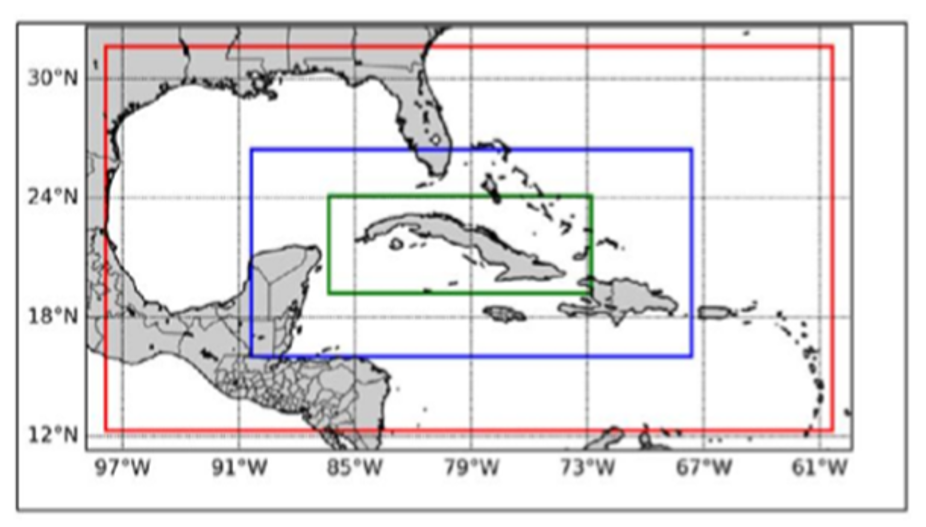Physical-meteorological factors that influence in the intensity of short-duration heavy rainfall in Cuba based on the SISPI model
Main Article Content
Abstract
At a local scale, locally intense short-duration rainfall is associated with the daily activity of thunderstorms. Sometimes, it causes significant negative impacts on social infrastructure and human safety, although it is not considered within the Severe Local Storms. Its prediction becomes very complex according to its great spatial and temporal variability, in addition to the mechanisms and multiplicity of factors that intervene in its generation. The main objective of this research is to determine the physical-meteorological factors that discriminate the occurrence of these intense events, thus contributing to the elaboration of their future short-term forecast. A series of factors were selected as possible discriminants and that, responding to laws and processes of physics, influenced the intensity of the precipitation. To check if they were effective, a comparison was established between cases in which the storms generated locally intense short-duration rainfall and cases in which they did not generate these phenomena, based on the calculation of thermodynamic variables. The most relevant result was attributed to the fact that all physical-meteorological factors presented values conducive to generating intense surface precipitation events.
Downloads
Article Details

This work is licensed under a Creative Commons Attribution-NonCommercial 4.0 International License.
Those authors who have publications with this journal accept the following terms of the License Attribution-NonCommercial 4.0 International (CC BY-NC 4.0):
You are free to:
- Share — copy and redistribute the material in any medium or format
- Adapt — remix, transform, and build upon the material
The licensor cannot revoke these freedoms as long as you follow the license terms.
Under the following terms:
- Attribution — You must give appropriate credit, provide a link to the license, and indicate if changes were made. You may do so in any reasonable manner, but not in any way that suggests the licensor endorses you or your use.
- NonCommercial — You may not use the material for commercial purposes.
- No additional restrictions — You may not apply legal terms or technological measures that legally restrict others from doing anything the license permits.
The journal is not responsible for the opinions and concepts expressed in the works, they are the sole responsibility of the authors. The Editor, with the assistance of the Editorial Committee, reserves the right to suggest or request advisable or necessary modifications. They are accepted to publish original scientific papers, research results of interest that have not been published or sent to another journal for the same purpose.
The mention of trademarks of equipment, instruments or specific materials is for identification purposes, and there is no promotional commitment in relation to them, neither by the authors nor by the publisher.
References
Byers, H.R. & Braham, R. R. (1948). “Thunderstorm Structure and Circulation”. U.S. Weather Bureau. Journal of Meteorology, Vol.5. No. 3: 71-86 pp.
Carnesoltas, M. (2002). “La brisa de mar y tierra. Conceptos fundamentales”. Revista Cubana de Meteorología, 9(1): 39–60 pp. ISSN: 0864-151X.
Carnesoltas, M.; Sierra, M.; Rabelo, D. & Fernández, E. (2013). “Factores físicos que influyen en la caída de granizos y en las aeroavalanchas sobre Cuba”. Informe de Resultado. Instituto de Meteorología, 65 pp.
Carnesoltas, M. (2019). “Tormentas locales severas. Tres condiciones necesarias”. Revista Cubana de Meteorología. Vol. 15, No. 1, 2019. E-ISSN: 0864-151X
Doswell, C. A.; Brooks, H. E. & Maddox, R. A. (1996). “Flash Flood Forecasting: An Ingredients-Based Methodology”. Weather and Forecasting, 11, 560-581. https://doi.org/10.1175/1520-0434 (1996)011<0560:FFFAIB>2.0.CO;2
Fernández, A. J. & Díaz, Y. (2005). “Catálogo de los Procesos Sinópticos del Archipiélago Cubano en el período 1979-1993”. Editorial Academia, pp. 167.
Kamburova, P. L. & Ludlam, F. H. (1966). “Rainfall evaporation in thunderstorm downdraughts”. Amer. Meteor. Soc., (92):510–518.
Moncrieff, M. W. & Green, J. S. (1972). “The propagation of steady convective overturning in shear”. Quarterly Journal of the Royal Meteorological Society, (98):336-352.
Monjo, R. (2010). “El índice n de la precipitación intensa”. www.Divulgameteo.Es. Retrieved from http://divulgameteo.es/uploaps/Indice-n.pdf. Consulted:Agosto 2022.
OMM, (1992). Vocabulario Meteorológico Internacional. Organización Meteorológica Mundial, No. 182, Ginebra, 784 pp.
Orbe, G. & Barcia, S. (2007). “Patrones sinópticos que generan días con lluvias localmente intensas en la mitad occidental de Cuba. Distribución temporal y espacial de las mismas”. Memorias IV Congreso Cubano de Meteorología, Ciudad de La Habana, pp. 13.
Orlanski, I. (1975). “A rational subdivision of scale for atmospheric processes”. Bull. Met. Soc., Vol. 65. No.1: 527–530pp.
Planos, E., Limia, M. & Vega, R. (2004). “Intensidad de las precipitaciones en Cuba”. Resultado Científico. Programa Ramal: “Análisis y pronóstico del tiempo y el clima terrestre y espacial”. 80 pp.
Rivero, R., Antuña, J. C. & Pérez, C. A. (1981). “Climatología sinóptica de las lluvias de más de 100 mm en el territorial Camagüey - Ciego de Ávila”. Boletín Científico Técnico, (5).
Rojas, Y. & Carnesoltas, M. (2013). “Configuraciones típicas que adoptan los campos de viento y temperatura a meso escala en la región oriental bajo la influencia de los patrones a escala sinóptica favorables para las tormentas locales severas”. Informe de Resultado. Instituto de Meteorología, p. 116.
Sierra, M.; Borrajero, I., Ferrer, A.; Morfa, Y.; Morejón, Y. & Hinojosa, M. (2017). Estudios de sensibilidad del SisPI a cambios de la PBL, la cantidad de niveles verticales y las parametrizaciones de microfísica y cúmulos, a muy alta resolución. Informe Científico de resultado, Instituto de Meteorología, La Habana, Cuba, 26 p., DOI: 10.13140/RG.2.2.29136.0005, Available https://www.researchgate.net/publication/325050959_Estudios_de_sensibilidad_del_SisPI_a_acmbios_de_la_PBL_la_cantidad_de_niveles_verticales_y_las_parametrizaciones_de_microfisica_y_cumulos_a_muy_alta_resolucion, [Consulted: August 10, 2022].
Srivastava, R. C. (1985). “A simple model of evaporatively driven down draft: Application to microburst downdraft”. J. Atmos. Sci., (42):1004–1023. DOI: 10.1175/1520-0469(1985)0422.0.CO;2.
Stull, R. (2015). “Practical meteorology: An algebra-based survey of atmospheric science”. Dept. of Earth, Ocean and Atmospheric Sciences, University of British Columbia. 939 pp. ISBN-13: 978-0-88865-176-1, Available: http://www.eos.ubc.ca/books/Practical_ Meteorology/
Varela, A. (2017). “Factores que intervienen en la formación de tornados en la región occidental de Cuba”. Tesis presentada en opción al grado de Máster en ciencias meteorológicas. La Habana, pp. 102. [Consulted: March 15, 2022].

